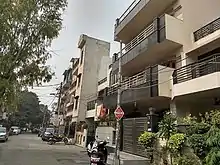Paschim Vihar
Paschim Vihar is a residential area in Delhi, India falling under the Punjabi Bagh subzone of West Delhi. A typical Delhi suburb that developed significantly in the 1980s, it is packed with apartment complexes functioning as group housing societies, built both privately as well as by the Delhi Development Authority. The Outer Ring Road divides Paschim Vihar into two parts.
Paschim Vihar
 Paschim Vihar | |
|---|---|
| Country | |
| State | Delhi |
| District | West Delhi |
| Founded by | DDA |
| Government | |
| • Type | Parliamentary Democracy |
| • Body | Municipal Corporation of Delhi |
| Elevation | 213 m (699 ft) |
| Population | |
| • Total | 400,000 - 800,000 |
| • Density | 20,425/km2 (52,900/sq mi) |
| Time zone | UTC+5:30 (IST) |
| PIN | 110063 and 110087 |
| Telephone Code | 011 |
| Sex ratio | 892 ♂/♀ |
| Literacy | 91.2% (Male), 82.5% (Female)% |
| Lok Sabha constituency | outer delhi |
| Vidhan Sabha constituency | Shakur Basti (Satyendra Kumar Jain), Nangloi Jat (Raghuvendra Shaukeen) |
| Civic Agency | MCD |
History
Settlements here started around the late 1970s and 1980s, thus this is a relatively old and green area. The east side was 'mostly' developed by the DDA where blocks were A, B, and C-blocks were formed and plots were allotted along with flats in Group Housings. The west side is 'mostly' privately developed. Huge sects of land (over 7-70 acres each) were allotted by the DDA to private societies on both sides. These societies then made roads (within their respective land) and erected other essential amenities by themselves and allotted plots to members.
Surroundings
There is a West Delhi Cricket Academy in Paschim Vihar which has produced cricketers like Virat Kohli. The Financial Mall also has its head office in Paschim Vihar. On the eastern side lies Punjabi Bagh, Madipur and Paschim Puri and on the northern side lies the Mangolpuri Industrial Area and Pitampura. On the western side lies Nangloi, Udyog Nagar, Mianwali Nagar and Surajmal Stadium, and on the southern side lies Keshopur, Janakpuri and Vikaspuri. Two parts of the area are also ruled by Gram Panchayats - Peera Garhi and Jwala Heri, where much of the latter has been converted for commercial usage into the Jwala Heri Market. Peera Garhi also has several workshops.
Nangloi Jat and Saiyyed Nangloi are the nearest areas which are adjacent to the western edge, and a little further are the village clusters of Kirari, Neher, Sultanpuri, and Nilothi. The area also accommodates 2 relocation camps which were built during the time of partition for refugees. These areas now house mainly poor and lower-middle-class people.
The Najafgarh Drain flows through the western edge at its southern part to a part away up to almost a kilometer away in the northern part. Nearby residential areas of Paschim Vihar include Punjabi Bagh, Madipur, Paschim Puri, Paschim Vihar Extension, Punjabi Bagh Extension, Bhera Enclave, Sunder Vihar, Meera Bagh, Jwalapuri, Guru Harkishan Nagar, Tilak Nagar, Vikaspuri, Janakpuri, Keshopur, Peeragarhi, Nangloi, Udyog Nagar, Pitampura and Rohini.